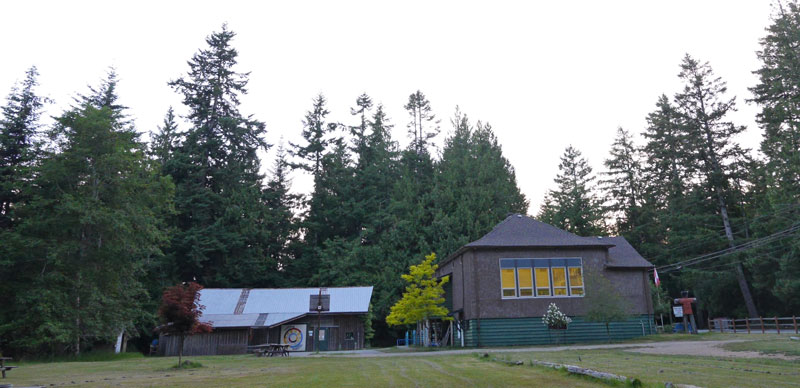
Old School bat cameras and monitor
During the winter of 2016-17 two cameras were installed in either side of the attic, pointed at roost sites where there had been large guano piles during the summer of 2016.


Bat Videos
May 2017 Daytime, bats in the attic: https://youtu.be/S5DipmNWNTg
June 2017 bats leaving the roof at dusk video: https://youtu.be/hq58M0x-mLs
June 2017 Evening, bats in the attic: https://youtu.be/sq-MbTCjpxA
Bat Species and Bat Stewardship at the Old School
For going on 30 years, while Denman Conservancy has been a tenant of the Islands Trust’s Old School building, the Conservancy has stewarded a large maternal bat colony in the School’s spacious attic. Female bats birth and raise their young through the spring and summer months, while foraging on a huge numbers of mosquitoes and other invertebrates in the area. An estimate of the numbers of the bats in the year 2000, by the Ministry of Environment bat expert Susan Holroyd, was a colony of about 1000 females. In 2000 and 2001, outside mist-net bat-capture and species identification techniques indicated at least Little brown and Long-eared bats at the Old school.
Following the summer of 2013, guano samples were taken from 8 bat roosts inside the attic. Bat species are thought to roost separately even when sharing a single roost area. Bat-species genetic analysis of these samples suggested that only Yuma bats were roosting over the DCA side of the attic, while at least three species shared the attic over the Denman Weavers: Little brown, Long-eared and Big brown bats. The two sides of the attic, over the DCA room and over the Weaver’s room, are actually separate spaces with a hole between them. This two-chambered attic was the result of the newer part of the Old School being built directly over an older one-room school, roof and all.
Subsequently, bats found around the Old school also have been identified as Little brown and Long-eared bats. When juvenile bats are learning to fly from mid-July on, they often aren’t as accomplished as their parents and sometimes can’t find their way home. Occasionally bats are found outside the building or inside the rooms. In addition, Anabat bat echolocation-call identification, conducted during the summer of 2016 when bats were leaving the Old school roof at dusk, showed at least Yuma and Little brown bats were present.
During the winter of 2016-17 two cameras were installed in either side of the attic, pointed at roost sites where there had been large guano piles during the summer of 2016. The guano accumulation in the attic is removed by a DCA volunteer each winter. Of note, a group of volunteers worked diligently in 2015 and 2016 to install plywood over the attic rafters, replacing tarps put down in the early 1990’s by earlier volunteers.
Currently only the camera in the Weavers’ side of the attic is showing bats. Why are there no bats on the DCA side? If this was still a Yuma roost is it something to do with that species, did they move sides? At this time we do not know!
Watching the bats on the Weaver’s side has suggested various interesting bat behaviours:
- First, many bats are incredibly noisy and restless sleepers. Daytime is normally “sleeping time for bats”, but the bats are noisy in the day, even when the outside noises, which seem really magnified in the attic, are not present.
- Second, in the cool early morning the bats are huddled together in the attic peak, but as the day heats up, the bats gradually disperse down the rafters, seemingly seeking cooler, less-crowded roost positions.
- Third, in late May, the numerous bats that were directly in front of the camera seem to have moved to the other end of the attic, while a few seemingly larger bats now occupy the space directly in front of the camera. Looking at the 2013 genetic data, this roost was then a Big brown bat roost site. So are these new site occupants the Big browns that have returned and pushed the smaller bats to the far end? There don’t seem to be very many of these big bats, currently less than a couple of dozen.
Counts of bats exiting the Old school roof will continue to be made at dusk periodically throughout the summer. The main roof-exit for the bats, at this time, is directly in front of the front entrance stairs. On the evening of May 30 between 9:40pm & 10:07pm, 693 bats left the Old School roof to go to drink and forage. Of note there were still a couple of dozen bats showing on the camera, indicating over 700 female bats in the Old school colony. Continued Anabat echolocation recordings of these bats will be made and new guano samples will be taken at the end of the summer. We continue to learn more about these fascinating animals!

